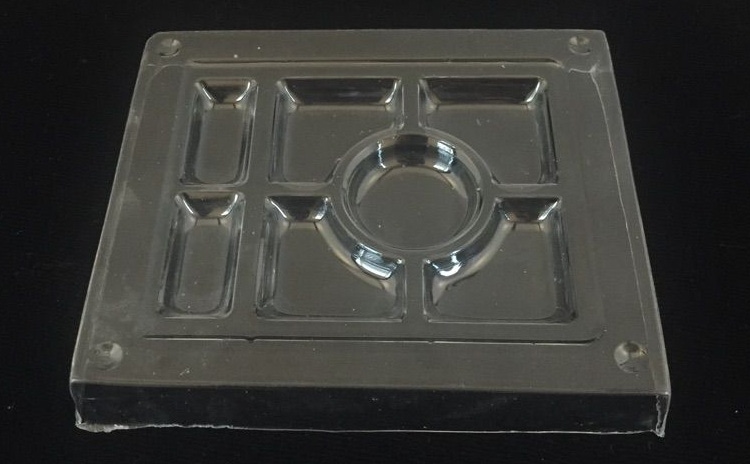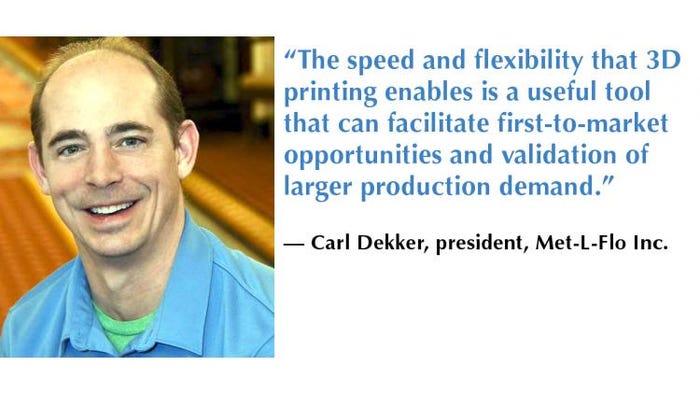How 3D printing helps with packaging parts and prototypes
May 4, 2018

One of the greatest general advancements in industrial computing has been the advent of additive manufacturing, more commonly known as 3D printing. Packaging is at the forefront of industries that can benefit from 3D printing.
Some of the latest advances in additive manufacturing increase its versatility to the point where it can simulate blow molding, create hollow prototypes of great complexity, work with a full range of packaging materials, use thermoforming to create prototypes of trays and blister packs, and much more.
Carl Dekker is president of Met-L-Flo Inc., an engineering firm specializing in additive manufacturing. He spoke with Packaging Digest about the potential uses of additive manufacturing in the packaging industry.
When it comes to packaging, which do you see as having more potential for 3D printing: parts for packaging machinery, models of the packages themselves, or both? What are the advantages of using 3D printing in these applications?
Dekker: Models will always be used in prototype applications for design validation and communication. Packaging machinery may increase for the flexibility and styling, but I think the biggest factor will be for customized products. The speed and flexibility that 3D printing enables is a useful tool that can facilitate first-to-market opportunities and validation of larger production demand.

Can you elaborate on the kinds of parts/packages that could most benefit from 3D printing? In other words, what aspects of these items, such as complex geometries, would make them good candidates for 3D manufacturing or modeling?
Dekker: It is hard to say which products will benefit most, as all of them can. The key candidates may be those looking to be more stylish and connected to their markets. If there is a champion in the organization who is applying the advantages, they may see the most impact.
How can the materials you use simulate packaging materials like ABS (acrylonitrile butadiene styrene), polypropylene or polycarbonate?
Dekker: We can use some of these materials direct from the machine or through low-volume tooled applications. This opens a lot of potential for flexibility and quick modifications to meet changing or specific market demands.
When it comes to machine parts, which are you called upon most often to produce: a prototype of a new one, or a replacement for an existing one?
Dekker: Most of the applications are for new products. To apply 3D printing to existing products is mostly growing for legacy products or applications where the tooling may no longer be available.
How is color mapping evolving, and what does this mean for packaging designers and engineers using 3D printers?
Dekker: Color mapping is improving in 3D printing systems. It is still not at the level most would expect, so secondary processing may be necessary to achieve the desired look. In time, this may improve more but that may take a little while.
What is the significance of Met-L-Flo being able to mimic processes like rotational blow molding and thermoforming when developing prototype packages? How does that translate to mass production of those packages?
Dekker: The processes we are using for rotational and blow molding are not very competitive for high volume production. They can help get production lines set up for high volume and can address a lot of custom or low-volume needs, but production tooling will still have a home. When products have high-volume demand, production tools will be the effective route. What may be more impacting are the specialized products and items that are not practical to produce at present due to production costs.
****************************************************************************
Production efficiencies, ecommerce challenges, sustainability trends, new bioplastic technologies and more are among the topics on the agenda at the new Packaging Education Hub at EastPack 2018 (June 12-14; NYC). This free educational program will have more than 15 hours of can’t-miss presentations, demonstrations and hands-on activities. Register to attend for free today!
About the Author(s)
You May Also Like


